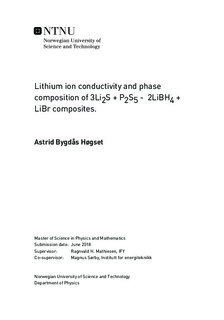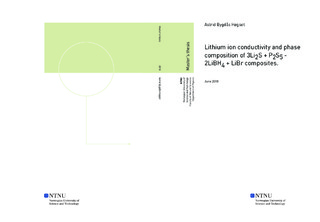| dc.description.abstract | The crystal structure and electrochemical properties of a mixed 3Li2S + P2S5 - 2LiBH4 LiBr system have been studied, with the aim to investigate relations between ionic conductivity and sample content, and to evaluate the materials electrochemical properties. Five samples with different concentration rates were synthesized by ball milling and annealing, and the crystalline phases were determined by powder X-ray diffraction, powder neutron diffraction and infrared spectroscopy. The ionic conductivities were decided by electrochemical impedance spectroscopy, and electrochemical properties were investigated through battery tests and cyclic voltammetry.
Impedance measurements showed ionic conductivities in the range 10-4-4 - 10-3 S cm-1 at room temperature, thus the materials are classified as superionic conductors. X-ray diffraction displayed that Li6PS5Br had been formed in all samples after synthesizing, while Li(BH4)(1-y)Bry was present in three out of the samples. It has previously been reported that the positions and the amount of substituted bromide in the structures effect how local ionic diffusivity translates to macroscopic ionic conductivity, and several structural features have been investigated in order to find a relation between crystal content and measured conductivities. It was however not possible to find an absolute correlation.
Concerning the structure of LB0.33LPS0.67, the structure model fitted to the X-ray diffraction data did not match with the neutron diffractogram. A new structure model of the Li6PS5Br phase was therefore introduced, including the possibility of borohydride substitution in the structure. The new model gave a better fit for both diffractograms, thus it is suggested that borohydride can be substituted into the argyrodite structure of Li7-x-yPS6-x-yBrx(BH4)y.
Battery cycling of the LB0.33LPS0.67 sample showed repeatable cyclability at C/20 and good stability towards the electrode material at 323 K, indicating that the material displays promising properties as electrolyte material. | |

